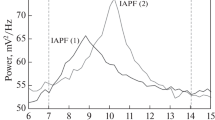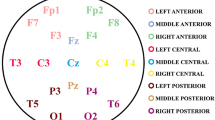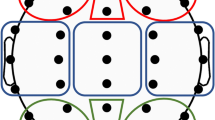Summary
Interpretation of the results from psychological examinations of 298 probands with inherited EEG variants requires (1) critical evaluation of previous literature on psychological EEG correlates, (2) knowledge of the main concepts and experimental approaches for elucidating the basic mechanisms of EEG rhythms, (3) discussion of previous attempts to link psychological variation in human populations with corresponding variation in brain function, and (4) interpretation of results from considerations at these three levels with the data from out own study.
At the first level (previous psychological studies), comparison with Schmettau's study proved to be especially revealing: Her conclusions about personality correlates with high α-index and with “flat” EEGs were very similar to ours with the monotonous α-(R) and low-voltage (N) EEGs, respectively. Her EEG type with high β-index overlaps with our β-diffuse (BD) type; a tendency to ssychasthenia and low resistance to stress is less obvious in our group, but is expressed indirectly by reduced speed and accuracy in tests requiring attentiveness and persistence. The correlation between α-frequency and intelligence found in other studies was confirmed by the especially high intelligence scores of our group with occipital fast α-variants (BO).
At the second and third levels of the discussion (EEG mechanisms; neurophysiological theories), the cooperation of cerebral cortex (EEG battery), thalamus (pacemaker), and ARAS (tonic arousal) is discussed, and the personality typologies of Eysenck and Claridge are mentioned. From this and other evidence, the following hypotheses are discussed:
-
1)
The personality profiles of the R group are influenced by high activity and efficiency of the thalamic α-pacemaker(s), which leads to a high degree of modulation, selection, and amplification of afferent stimuli.
-
2)
In the countertype of this EEG variant, the N EEG, a low modulation and amplification by the thalamic α-pacemaker is assumed. This leads to relatively low intensity of feeling and to low spontaneous activity, but to faster information processing. Combined with an increased level of tonic arousal in the ARAS, it may cause certain ‘neurotic’ complaints (our low-voltage borderline (NG) group).
-
3)
The EEG with diffuse β-waves (BD) is caused by a high level of tonic arousal in the ARAS, which tends to disturb the thalamocortical circuit. This leads to reduced stress resistance and to impairment of intellectual functions, especially space perception. Due to limited evidence, the next two hypotheses are advanced only tentatively:
-
4)
α-rhythm with very high frequency (16–19 c/s) leads to improvement of information processing and, hence, to high intellectual performance and motor dexterity.
-
5)
Probands with frontoprecentral β-groups (BG) show no psychological signs of increased tonic arousal; therefore, these β-groups are caused not by increased tonic arousal of the ARAS, but by a genetic variant of a thalamic subsystem.
Similar content being viewed by others
References
Anastasi, R.: Differential psychology. New York: MacMillan 1958
Andersen, P., Andersson, S. A.: Physiological basis of the alpha rhythm. New York. Appleton-Century-Crofts 1968
Andersen, P., Andersson, S. A.: Thalamic origin of cortical rhythmic activity. Handbook of electroencephalography and clin. neurophysiology, Vol. 2, Part C, pp. 2C-90–2C-118. Amsterdam: Elsevier 1974
Andersen, P., Andersson, S. A., Lømo, L.: Some factors involved in the thalamic control of spontaneous barbiturate spindles. J. Physiol. (London) 192, 257–281 (1967a)
Andersen, P., Andersson, S. A., Lømo, L.: Nature of thalamocortical relations during spontaneous barbiturate spindle activity. J. Physiol. (London) 192, 283–307 (1967b)
Becker, P. E.: Die Neurosen im Lichte der Genetik. Dtsch. Med. Wochenschr. 83, 612 (1958)
Becker, D.: Hirnstromanalysen affektiver Verläufe. Göttingen: Hogrefe 1972
Berger, H.: Uber das Elektrenkephalogramm des Menschen. 1. Mitteilung. Arch. Psychol. (Frankf.) 87, 527 (1929)
Berger, H.: Uber das Ekektrenkephalogramm des Menschen. 3. Mitteilung. Arch. Psychol. (Frankf) 94, 16 (1931)
Berger, H.: Uber das Elektrenkephalogramm des Menschen. 14. und 15. Mitteilung. Arch. Psychol. (Frankf.) 106, 165 und 577 (1937)
Berger, H.: Das Elektrenkephalogramm des Menschen, Bd. 6, Nr. 38. Halle: Nova Acta Leopoldina 1938
Birbaumer, N.: Physiologische Psychologie. Berlin-Heidelberg-New York: Springer 1975
Birnstock, Holman: 1961 quoted from Andersen and Andersson 1968
Brazier, M. A. B., Finesinger, J. E., Cobb, S.: A contrast between the electroencephalograms of 100 psychoneurotic patients and those of 500 normal adults. Am. J. Psychiatry 101, 443–448 (1945)
Bremer, F.: Cerveau “isolé” et physiologie du sommeil. C.R. Soc. Biol. (Paris) 118, 1235–1241 (1935)
Bremer, F.: L'activité électrique de l'écorce cérébrale. Paris: Hermann & Cie. Actual. Scientifique industrielles 658, 46 (1938)
Christian, W.: Klinische Elektroenzephalographie. Stuttgart: Thieme 1975
Claridge, G. S.: Personality and arousal. Oxford: Pergamon 1967
Claridge, G. S., Canter, S., Hume, W. I.: Personality differences and biological variations: A study in twins. Oxford: Pergamon Press 1973
Creutzfeldt, O.: Neurophysiologische Grundlagen des Elektroencephalogramms. In: Neurophysiologie, M. Haider, ed. Bern-Stuttgart-Wien: Huber 1971
Creutzfeldt, O., Houchin, J.: Neuronal basis of EEG waves. Handbook of electroencephalography and clin. neurophysiology, Vol. 2, Part C, pp. 2C-3–2C-55. Amsterdam: Elsevier 1974
Dahlstrom, W. G., Welsh, G. S., Dahlstrom, L. E.: An MMPI handbook, Vol. I, Clinical interpretation. Univ. of Minnesota, rev. ed. 1972
Derbyshire, A. J., Rempel, B., Forbes, A., Lambert, E. F.: The effects of anaesthetics on action potentials in the cerebral cortex of the cat. Am. J. Physiol. 116, 577–596 (1936)
De Fries, J. C., Vandenberg, S. G., McClearn, G. E.: Genetics of specific cognitive abilities. Am. Rev. Genet. 10, 179–207 (1976)
Dieker, H.: Untersuchungen zur Genetik besonders regelmäßiger hoher Alpha-Wellen im EEG des Menschen. Hum. Genet. 4, 189–216 (1967)
Eccles, J. C.: Interpretation of action potentials evoked in the cerebral cortex. Electroencephalogr. Clin. Neurophysiol. 3, 449–464 (1951)
Ehrman, L., Parsons, P. A.: The genetics of behavior. Sunderland, MA: Sinauer 1976
Ellingson, R. J.: Brain waves and problems of psychology. Psychol. Bull. 53, 1–34 (1956)
Ellingson, R. J., Wilcott, R. C., Sineps, J. G., Dudek, F. J.: EEG frequency-pattern variation and intelligence. Electroencephalogr. Clin. Neurophysiol. 9, 657–660 (1957)
Ellingson, R. J., Lathrop, G. H.: Intelligence and frequency of the alpha rhythm. Am. J. Ment. Defic. 78, 334–338 (1973)
Eysenck, H. J.: The biological basis of personality. Springfield: Thomas 1970
Finesinger, J. E., Cobb, S.: A contrast between the electroencephalogram of 100 psychoneurotic patients and those of 500 normal adults. Am. J. Psychiatry 101, 443–448 (1945)
Friedl, W., Vogel, F.: The sex differences in the normal resting EEG of young adults. Z. EEG-EMG (in press, 1979a)
Frield, W., Vogel, F.: The resting EEG in relation to neurovegetative status and spatial perception in normal, young adults. Z. EEG-EMG (in press, 1979b)
Fuller, J. L., Thompson, N. R.: Behavior genetics. New York: Wiley 1960
Gastaut, H.: Confrontations entre les donnés de l'électroencéphalogramme et des examens psychologique chez 522 sujets repartis en trois groupes différents. Conclusions d'ensemble. In: Conditionnement et réactivité en électroencéphalographie. Paris (1957)
Golla, F. J., Hutton, E. L., Walter, W. G.: Objective study of mental imagery; physiological contribute. Appendix on new methods of EEG analysis. J. Ment. Sci. 89, 216–223 (1943)
Hill, D.: Psychiatry. In: Electroencephalography, D. Hill, G. Parr, eds. London: Churchill 1950
Hill, D.: Electroencephalography. In: Recent advantages in neurology and neuropsychiatry, R. Brain, E. B. Strauss, eds. London: Churchill 1955
Høncke, P., Strömgren, E., Zahle, V.: Elektrenkephalographische Untersuchungen an Psychopaten. Arch. Psychiatr. Nervenkr. 183, 55–63 (1949)
Itil, T. M.: Quantitative und qualitative EEG-Befunde bei Schizophrenen. Z. EEG-EMG 9, 1–13 (1978)
Janz, D.: Die Epilepsien, Stuttgart: Thieme 1969
Jarvik, L. F.: Human intelligence: Sex differences. Acta Genet. Med. (Roma) 24, 189–211 (1975)
Jasper, H. H.: Diffuse projection systems: The integrative action of the thalamic reticular system. Electroencephalogr. Clin. Neurophysiol. 1, 405–420 (1949)
Jung, R.: Neurophysiologische Untersuchungsmethoden. In: Handbuch der inneren Medizin, 4. Aufl. Bd. V/1, 1206–1420 (1953)
Jung, R.: Hirnpotentialwellen, Neuronentladungen und Gleichspannungsphänomene. Jenenser EEG-Symposium; 30 Jahre Ekektroencephalographie, 54–81. Berlin: VEB Volk und Gesundheit 1963
Knott, J. R., Henry, C. E., Hadley, J. M.: Brain potentials during sleep: A comparative of the dominant and nondominant alpha-groups. J. Exp. Psychol. 24, 157–168 (1939)
Knott, J. R., Travis, L. E.: A note on the relationship between duration and amplitude of cortical potentials. J. Psychol. 3, 169–172 (1937)
Kristiansen, K., Curtois, G.: Rhythmic electrical activity from isolated cerebral cortex. Electroencephalogr. Clin. Neurophysiol. 1, 265–272 (1949)
Kugler, J.: Elektroencephalographie in Klinik und Praxis, 2. Aufl. Stuttgart: Thieme 1966
Kuhlo, W., Heintel, H., Vogel, F.: The 4–5/sec rhythm. Electroencephalogr. Clin. Neurophysiol. 26, 613–618 (1969)
Lindsley, D. B.: Psychological phenomena and the electroencephalogram. Electroencephalogr. Clin. Neurophysiol. 4, 443–456 (1952)
Loomis, S. D., Hobart, H.: Electrical potentials of the human brain. J. Exp. Psychol. 19, 249–279 (1936)
McAdam, W., Orme, J. E.: Personality traits and the normal electroencephalogram. J. Ment. Sci. 100, 913 (1954)
Morison, R. S., Basset, D. L.: Electrical activity of the thalamus and basal ganglia in decorticate cats. J. Neurophysiol. 8, 309–314 (1945)
Morison, R. S., Dempsey, E. W.: A study of thalamocortical relations. Am. J. Physiol. 135, 281–292 (1942)
Morison, R. S., Dempsey, E. W.: Mechanism of thalamocortical augmentation and repetition. Am. J. Physiol. 138, 297–308 (1943)
Morison, R. S., Finley, K. H., Lothrop, G. N.: Spontaneous electrical activity of the thalamus and other forebrain structures. J. Neurophysiol. 6, 243–254 (1943)
Moruzzi, G., Magoun, H. W.: Brain stem reticular formation and activation of the EEG. Electroencephalogr. Clin. Neurophysiol. 1, 455–473 (1949)
Müller-Küppers, M., Vogel, F.: Über die Persönlichkeitsstruktur von Trägern einer seltenen erblichen EEG-Variante. Jb. Psychol. Psychother. med. Anthropol. 12, 75–100 (1965)
Mundy-Castle, A. C.: The relationship between primary-secondary function and the alpharhythm of the electroencephalogram. J. Natl. Inst. Personnel Res. 6, 95–102 (1955)
Mundy-Castle, A. C.: L'électroencéphalogramme et sa relation avec le tempérament. In: Conditionnement et réactivité en électoencéphalographie. Paris: Masson, 1957
Mundy-Castle, A. C.: Electrophysiological relates of intelligence. J. Pers. 26, 184–199 (1958)
Mundy-Castle, A. C., Nelson, G. K.: Intelligence, personality and brain rhythm in a socially isolated community. Nature 185, 484–485 (1960)
Murken, J. D.: The XYY-syndrome and Klinefelter's syndrome. Topics in human genetics, P. E. Becker, ed., Vol. II. Stuttgart: Thieme 1973
Neundörfer, B.: Über die 4–5/sec EEG-Grundrhythmusvariante. Nervenarzt 41, 321–326 (1970)
Ostow, M.: Psychic function and the electroencephalogram. Arch. Neurol. Psychiat. (Chicago) 64, 385–400 (1950)
Palmer, B. M., Rock, H. A.: High alpha-incidence in the EEG and personality patterning. Electroencephalogr. Clin. Neurophysiol. 3, 374 (1951)
Propping, P.: Genetic control of ethanol action in the central nervous system. An EEG study in twins. Hum. Genet. 35, 309–334 (1977)
Propping, P.: Alcohol and alcoholism. Hum. Genet. Suppl. 1, 91–99 (1978)
Propping, P., Kopun, M.: The kinetics of ethanol absorption and elimination in twins and supplementary repetitive experiments in singleton subjects. Eur. J. Clin. Pharmacol. 11, 337–344 ()
Propping, P., Friedl, W., Nebel, B., Feige, A.: Plasma DBH, platelet MAO and proteins of red blood cell membranes in individuals with variants of the normal EEG. Neuropsychobiology (in press, 1979)
Reinke, G.: Zur genetischen Grundlage der sogenannten Grenzfälle des Niederspannungs-EEG und der diffusen β-Wellen bei jungen Männern. Dissertation, Heidelberg 1966
Remond, A., Lesevre, N.: Remarques sur l'activité cérébrale des sujets normaux. (La typologie électroencéphalographique dans ses rapports avec certain caractères psychologique). In: Conditionnement et réactivité en électroencéphalographie. Paris: Masson 1957
Remy, M.: L'affectivité dans l'électroencéphalogramme. Ann. Med. Psychol. (Paris) 107, 341 (1949)
Rubin, S., Bowman, K. M.: Electroencephalographic and personality correlates in peptic ulcer. Psychosom. Med. 4, 309 (1942)
Rubin, S., Moses, L.: Electroencephalographic studies in asthma with some personality correlates. Psychosom. Med. 6, 31 (1944)
Saul, L. J., Davis, H., Davis, P. A.: Correlations between electroencephalograms and the psychological organization of the individual. Trans. Am. Neurol. Assoc. 63, 167–169 (1937)
Saul, L. J., Davis, H., Davis, P. A.: Psychologic correlations with the electroencephalogram. Psychosom. Med. 11, 361–376 (1949a)
Saul, L. J., Davis, H., Davis, P. A.: Psychological correlations with the electroencephalogram. Electroencephalogr. Clin. Neurophysiol. 1, 515 (1949b)
Schepank, H.: Erb- und Umweltfaktoren bei Neurosen. Berlin-Heidelber-New York: Springer 1974
Schlag, J.: Reticular influences on thalamo-cortical activity. Handbook of electroencephalography and clin. neurophysiol., Vol. 2, Part C, 2C-119–2C-134 (1974)
Schmettau, A.: Korrelationsstatistische Untersuchung über den Zusammenhang zwischen EEG und Persönlichkeitsmerkmalen. Dissertation, Köln 1969
Schmettau, A.: Zwei elektroencephalographische Merkmalsverbände und ihre psychologischen Korrelate. EEG-EMG, Bd. 1, Nr.4, 169–182 (1970)
Shagass, C.: An attempt to correlate the occipital alpha-frequency of the electroencephalogram with performance on a mental ability test. J. Exp. Psychol. 36, 88–92 (1946)
Sisson, B. D., Ellingson, R. J.: On the relationship between “normal” EEG patterns and personality variables. J. Nerv. Ment. Dis. 121, 353–358 (1955)
Tsuboi, T., Nielsen, J.: Electroencephalographic examination of 50 women with Turner's syndrome. Acta Neurol. Scand. 54, 359–365 (1976)
Vogel, F.: Über die Erblichkeit des normalen Elektroencephalogramms. Stuttgart: Thieme 1958
Vogel, F.: Ergänzende Untersuchungen zur Genetik des menschlichen Niederspannungs-EEG. Dtsch. Z. Nervenheilk. 184, 105–111 (1962a)
Vogel, F.: Untersuchungen zur Genetik der β-Wellen im EEG des Menschen. Dtsch. Z. Nervenheilk. 184, 137–173 (1962b)
Vogel, F.: Zur genetischen Grundlage fronto-präzentraler β-Wellen-Gruppen im EEG des Menschen. Hum. Genet. 2, 227–237 (1966a)
Vogel, F.: Zur genetischen Grundlage occipitaler langsamer β-Wellen im EEG des Menschen. Hum. Genet. 2, 238–245 (1966b)
Vogel, F.: The genetic basis of the normal human electroencephalogram. Hum. Genet. 10, 91–114 (1970)
Vogel, F., Fujiya, Y.: The incidence of some inherited EEG variants in normal Japanese and German males. Hum. Genet. 7, 38–42 (1969)
Vogel, F., Götze, W.: Familienuntersuchungen zur Genetik des normalen Elektroencephalogramms. Dtsch. Z. Nervenheilk. 178, 668–700 (1959)
Vogel, F., Götze, W.: Statistische Betrachtungen über die β-Wellen im EEG des Menschen. Dtsch. Z. Nervenheilk. 184, 112–136 (1962)
Vogel, F., Motulsky, A. G.: Human genetics: Problems and approaches. Berlin-Heidelberg-New York: Springer 1979
Vogel, F., Schalt, E., Krüger, J., Propping, P., Lehnert, K. F.: The electroencephalogram as a research tool in human behavior genetics: Psychological examinations in healthy males with various inherited EEG variants. I. Rationale of the study; materials; methods; heritability of test parameters. Hum. Genet. 47, 1–45 (1979a)
Vogel, F., Schalt, E., Krüger, J.: The electroencephalogram as a research tool in human behavior genetics: Psychological examinations in healthy males with various inherited EEG variants. II. Results. Hum. Genet. 47, 47–80 (1979b)
Vogel, W., Broverman, D. M.: Relationship between EEG and test intelligence. Psychol. Bull. 62, 132–144 (1964)
Walter, Grey, W.: Das lebende Gehirn (The living brain). München/Zürich: Knaur 1963
Weinshilboum, R. M., Schrott, H. G., Raymond, F. A., Weidman, W. H., Elveback, L. R.: Inheritance of very low serum dopamine-β-hydroxylase. Am. J. Hum. Genet. 27, 573–585 (1975)
Weinshilboum, R. M.: Human biochemical gentics of plasma dopamine-β-hydroxylase and erythrocyte catechol-O-methyltransferase. Hum. Genet. Suppl. 1, 101–112 (1978)
Werre, P. F.: The relationship between electroencephalographic and psychological data in normal adults. Universitaire Pers. Leiden 1957
Winter, H., Herschel, M., Propping, P., Friedl, W., Vogel, F.: A twin study on three enzymes (DBH, COMT, MAO) of catecholamine metabolism. Correlations with MMPI. Psychopharmacology 57, 63–69 (1978)
Witkin, H. A., Mednick, S. A., Schulsinger, F., Bakkestrøm, E., Christiansen, K. O., Goodenough, D. R., Hirschhorn, K., Lundsteen, C., Owen, D. R., Rubin, D. B., Stocking, M.: Criminality in XYY and XXY men. Science 193, 547–555 (1976)
Züblin, W.: Chromosomen-Aberrationen und Psyche. Basle: Karger 1969
Author information
Authors and Affiliations
Rights and permissions
About this article
Cite this article
Vogel, F., Schalt, E. The electroencephalogram (EEG) as a research tool in human behavior genetics: Psychological examinations in healthy males with various inherited EEG variants. Hum Genet 47, 81–111 (1979). https://doi.org/10.1007/BF00295571
Received:
Issue Date:
DOI: https://doi.org/10.1007/BF00295571




